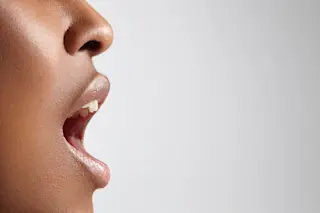Neuroscientists have developed an unusual new tool to help in recording brain activity — a mouth-based magnetic sensor.
The researchers, Tim M. Tierney et al. of University College London, built the device in order to record activity in the hippocampus, an area deep in the brain.
Because of the hippocampus's deep location, it is difficult to record its activity using methods such as electroencephalography (EEG) or magnetoencephalography (MEG), which record at the scalp.
Tierney et al. realized that the magnetic fields produced by hippocampal activity should be strong inside the mouth. The only problem was getting an MEG sensor in there and keeping it in a stable position. They came up with the idea of attaching a the sensor (called an OPM) to a custom-fitted plastic dental mould. The mould was created to fit the teeth of a volunteer, allowing him to bite down on it, holding it inside his ...














